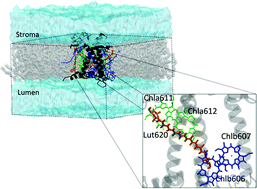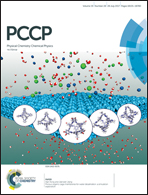Coulomb couplings in solubilised light harvesting complex II (LHCII): challenging the ideal dipole approximation from TDDFT calculations†
Abstract
The light harvesting complex II (LHCII), is a pigment–protein complex responsible for most of the light harvesting in plants. LHCII harvests sunlight and transfers excitation energy to the reaction centre of the photo-system, where the water oxidation process takes place. The energetics of LHCII can be modulated by means of conformational changes allowing a switch from a harvesting to a quenched state. In this state, the excitation energy is no longer transferred but converted into thermal energy to prevent photooxidation. Based on molecular dynamics simulations at the microsecond time scale, we have recently proposed that the switch between different fluorescent states can be probed by correlating shifts in the chromophore–chromophore Coulomb interactions to particular protein movements. However, these findings are based upon calculations in the ideal point dipole approximation (IDA) where the Coulomb couplings are simplified as first order dipole–dipole interactions, also assuming that the chromophore transition dipole moments lay in particular directions of space with constant moduli (FIX-IDA). In this work, we challenge this approximation using the time-dependent density functional theory (TDDFT) combined with the frozen density embedding (FDE) approach. Our aim is to establish up to which limit FIX-IDA can be applied and which chromophore types are better described under this approximation. For that purpose, we use the classical trajectories of solubilised light harvesting complex II (LHCII) we have recently reported [Liguori et al., Sci. Rep., 2015, 5, 15661] and selected three pairs of chromophores containing chlorophyll and carotenoids (Chl and Car): Chla611–Chla612, Chlb606–Chlb607 and Chla612–Lut620. Using the FDE in the Tamm–Dancoff approximation (FDEc-TDA), we show that IDA is accurate enough for predicting Chl–Chl Coulomb couplings. However, the FIX-IDA largely overestimates Chl–Car interactions mainly because the transition dipole for the Cars is not trivially oriented on the polyene chain.



 Please wait while we load your content...
Please wait while we load your content...